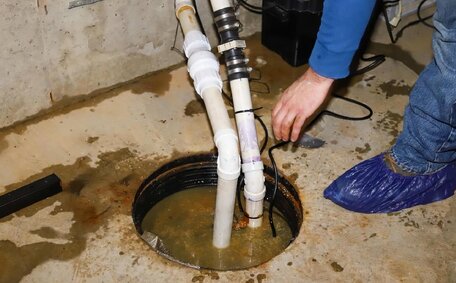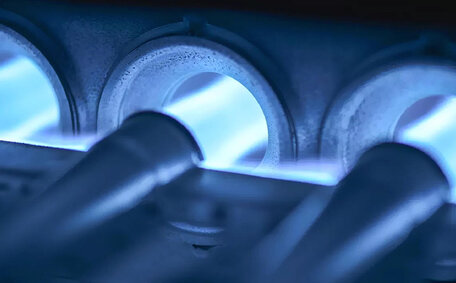How Tree Roots Can Damage Plumbing
Tree roots entering pipes pose a significant threat to plumbing systems due to their invasive and destructive effects. With root systems growing aggressively, they actively seek out sources of moisture and nutrients. Cracks or damaged sections of underground pipes provide an ideal entry point for tree roots growing your sewer system to penetrate.
Roots that infiltrate your drains can wreak havoc on your plumbing, leading to severe issues such as blocked drains, pipe breakages, and sewage backups. Tree root intrusion becomes more severe as the roots expand and exert immense pressure on pipe walls, resulting in significant pipe damage. Old clay and PVC pipes are especially prone to root growth, which can cause relentless cracking and damage.
Unchecked tree root infiltration into your sewer main can lead to emergencies such as major sewer clogs and water pipe drain collapses. Leaks from damaged water pipes can lead to an undermined soil structure around your drainage system due to expanding roots obstructing your pipe. Left unchecked, roots growing your underground plumbing system can, over time, lead to complete destruction.
By understanding what to do about the risk of roots infiltrating your drain pipes, As a homeowner, you can engage in proactive preventive measures on your own. Catching issues early, such as when there are signs tree roots may be affecting your plumbing, can help avoid costly repairs in your pipes network. The next sections delve into warning signs, solutions, Maintenance tips, and measures to prevent extensive tree roots damaging your pipes.
Identifying Signs of Tree Root Invasion
There are several signs tree roots may be intruding upon your plumbing system, indicating a possible invasion. The most common signs are damages visible near your property’s surface, indicative of pipes causing underlying disruptions. Cracks or sinkholes that appear can be rather telling, as they undermine and erode soil encasing your drainage system.
Noticeably lush, green patches of grass near trees your backyard hosts can indicate areas where roots have accessed your water supply.
You may also notice more subtle changes inside your home.
Slow draining sinks, showers, and toilets can often indicate roots obstructing pipes, which restricts water flow. A your blocked drain and sewage odours inside are serious red flags for roots damaging your system requiring immediate attention to clear.
Detecting tree root damage early significantly improves the prognosis for your pipes. It’s recommended that homeowners regularly inspect their yard for new cracks, monitor drainage, and contact a professional plumber at any sign of issues. Advanced CCTV drain cameras can also check for issues caused by tree roots in the sewer pipe before major damage arises.
Regular monitoring and prompt action are key to keeping your sewer lines free from major disruptions caused by tree roots. If neglected, removing large invasive root balls from collapsed pipes often necessitates excavators, pipe repairs and replacements, rehabilitation of your landscape, and drainage restoration.
Most Vulnerable Areas for Tree Root Damage
Intrusions by tree roots into sewer lines can lead to considerable damage to underground sewer and drainage systems. Old sewer pipes, crucial to your sewer system, are at risk from tree roots drains intrusions, which compromise the flow water and make them highly prone to cracks. The brittle nature of these pipes raises concerns due to their susceptibility to breakages when roots expand inside your sewer lines.
Joints between sections of pipes provide an easy way into the system for tree roots. Tree proximity intensifies vulnerability – The closer roots sewer line proximity, the higher the risk of extensive root damage. High soil moisture areas around Leaky taps or poor drainage accelerate how roots grow toward water sewer sources.
Your sewer lines and lateral connection lines situated near trees near your home frequently sustain heavy root intrusion. Tree roots your sewer line should consider should be at least 3 metres from this critical infrastructure. Strategic root barriers can prevent tree roots from getting lodged and inflicting further damage to pipes.
Early intervention by identifying vulnerable areas through camera inspection allows proactive maintenance like root foaming or removal before major blockages arise. Identifying the most at-risk zones is crucial to prevent roots in your pipes from causing extensive damage.
Solutions for Removing Tree Roots
There are several methods to remove tree roots that have invaded plumbing pipes.
Manual Root Cutting
For a minor blocked drain, homeowners can attempt manually clearing roots with drain snakes or augers.
For particularly stubborn blockages, it’s advisable to consult professionals who can ensure roots are effectively removed and don’t return to cause further damage.
High Pressure Hydro-Jetting
Plumbers use industrial hydro-jetters producing 5000+ psi bursting force to scour roots from your pipes completely clean. It’s an efficient process for clearing even major root infestations or collapsed drains.
High velocity jets of hot water efficiently sweep away tree roots and debris from drains. Hydro-jetting not only removes root obstructions but also cleans your pipes, paving the way for trenchless pipe relining.
Chemical Root Control
Applying copper sulphate, rock salt, or commercial root killer chemicals prevents regrowth after initial root removal. It’s important to make sure the correct dosage and careful handling are practised as chemicals can damage pipes if overused.
Foaming these products into pipes coats roots, stopping further intrusion. Skilled plumbers can ensure that chemicals are used appropriately to avoid environmental harm.
For severe cases, excavation to access pipes and remove extensive tree roots your pipes may be necessary. Professionals can then replace damaged sections or install new root-resistant pipes. They also advise adjusting tree placement, barriers and drainage to make future root invasion less likely.
Our team can inspect the full extent of root infiltration and tailor solutions to prevent recurrence. With advanced tools and expertise, we restore functionality protecting your plumbing assets. Should you require support or advice, don’t hesitate to call us on the Gold Coast for urgent assistance or proactive maintenance.
Preventing Future Tree Root Issues
There are several effective strategies to help prevent future tree root damage to your plumbing system.
Strategic Tree Placement
Carefully consider location when planting new trees. Make a conscious decision about where to plant near your home, Ensuring there’s at least a 3-metre buffer between these plants and pipes or drainage infrastructure. Opt for smaller trees shrubs species with a less extensive root system and thus less prone to causing damage near infrastructure.
Physical Barriers
Installing solid copper mesh or polyethylene root barriers around at-risk drains/pipes creates an impenetrable defence. Protective sleeves also guide roots away your critical lateral connections. This is especially important when working around pre-existing trees.
Root-Resistant Pipes
Alternatively relining degraded pipes can form an inner protective "pipe within a pipe".
Its smooth surface proved very effective at deterring root adhesion.
Proactive regular drainage inspections enable early intervention against potential root issues into your plumbing network. Advanced camera checks by professionals determine vulnerability, ensuring you stay ahead of problems before they escalate into costly emergency repairs. Get in touch with us to discuss maintenance plans or protective measures tailored to your needs.
Dealing with Insurance and Liability
Homeowners insurance policies have varying provisions regarding tree root damage coverage. Review your policy or consult professionals to understand exact details relevant to your situation.
Standard policies generally exclude natural vegetation-related damage. However, factors like negligence (for example, knowing tree proximity risks yet delaying action) may affect claims outcomes. Discuss options with your insurer early when problems arise.
If existing trees are implicated, homeowners may share liability by negligently allowing roots to endanger infrastructure through lack of inspection or maintenance. Insurers can subrogate against neighbours with problem trees.
For new plantings, be upfront with neighbours on tree species size and root profiles before planting. Seek written agreements on future removal or pruning plans should issues emerge. This documentation will protect your interests in liability disputes.
Work collaboratively with insurers and neighbours if repairs become necessary. Document all incidents thoroughly as evidence to strengthen your policy position. Ultimately preventing or rectifying root risks promptly before serious plumbing failures eventuate remains the key goal.
Maintaining Your Plumbing System
Implementing a comprehensive tree root plumbing maintenance plan is crucial for protecting against these invasive growths. This involves periodically inspecting your entire system, responding urgently to early warning signs, and arranging annual professional drainage assessments.
Conduct Regular Inspections
Routinely inspect your property for new cracks or soil shifts near your pipes.
Listen for gurgling sounds which are clear signs blocked sinks or toilets, suggesting possible blockages.
Respond Promptly to Problems
Address sluggish drainage immediately rather than ignoring warnings. Use camera inspection to diagnose issues early while resolutions are simpler. Address sluggish drainage immediately rather than ignoring warnings.
Acting swiftly can mitigate damage and reduce the extent of repairs needed.
Annual Plumbing Assessments
Your local plumbers thoroughly review systems using specialised tools, checking pipe integrity and root infiltration. They provide written reports advising on necessary repairs or preventative measures. Keep detailed records of all assessments, faults found, repairs conducted and costs.
Being informed about your plumbing health status enables interception of plumbing problems before catastrophic failure. Monitoring also indicates risks requiring priority repair budgets. Contact us to tailor a maintenance plan protecting your assets.






